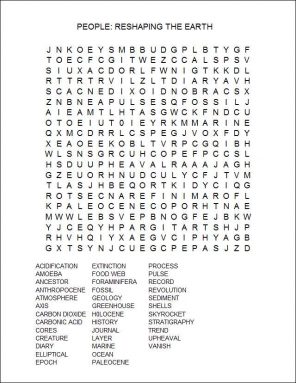How people have been shaping the Earth
Humans are changing the planet so fast that many scientists are now referring to this epoch as the Anthropocene

Mountaintop coal mining, as seen here in West Virginia, has been excavating and hauling away the rock that used to top many area mountains. This is just one way that humans are reshaping the environment.
Bread for the World/Flickr (CC BY-NC 2.0)
Earth’s history is written in its rocks. Over time, new layers accumulate above the older ones. Like the pages of a journal, those layers of rock record the events that have shaped our planet for much of its history. These events include the geology of a location. Rock also records the evolution of the plants, animals and other organisms that lived nearby. Their fossil remains hold clues to what the climate had been like. A rock’s mineral layers even mark how climate, rocks and organisms could, and did, change — sometimes in the blink of an eye.
The geologic record is not a complete historical account. Far from it. It is more like a diary that’s been tattered and torn. A few pages remain, but many have been destroyed by erosion, the collision of tectonic plates and the upheaval of mountains.
The surviving rock record does tell us almost everything we know about Earth throughout the majority of its 4.54 billion-year past. Geologists call that vast span geologic time. They divide it into successively briefer intervals, called eons, periods, epochs, eras and ages.
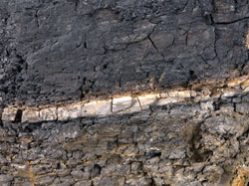
From the smallest bacterium to the tallest tree, all of life on Earth contributes to the chemical and physical changes that make our planet what it is today. One species, however, has come to dominate: People.
Beginning with our early ancestors and their taming of fire, humans have put technology to use in altering Earth. Our use of science and engineering sets us apart from all other organisms. We are constantly modifying the land, oceans and atmosphere. Our impact is so great that some scientists think we have become the dominant force of change. Accordingly, these experts propose we have entered a new geologic epoch of our own making.
Welcome to the Anthropocene.
Dawn of a new epoch
Anthropocene (AN-throh-puh-seen) combines the Greek words for human and new. Biologist Eugene Stoermer at the University of Michigan in Ann Arbor coined the term in the 1980s. Only later, in 2002, did chemist Paul Crutzen of the Max Planck Institute for Chemistry in Mainz, Germany, popularize its use. Stoermer and Crutzen reasoned that our impact on the planet has been especially measurable since the late 1800s. They proposed the term Anthropocene to describe how humans rose to become the dominant force of change on Earth.
And those changes are not trivial. Crutzen estimates that humanity’s impacts will last for thousands — if not millions — of years.
If accepted as a new epoch, the Anthropocene would follow the Holocene. (Holocene combines the Greek words for entirely and recent.) The Holocene began 11,700 years ago. This marked the end of the last ice age.
Ice ages begin every 100,000 years or so and last a long time. As temperatures cool, snowfalls during the Arctic winter increase, and snowmelts in summer decline. That snow reflects the sun’s warming rays, causing temperatures to drop still more. Over time, masses of ice more than three kilometers (two miles) thick can blanket large swaths of the Northern Hemisphere. That ice cover can last for tens of thousands of years before an abrupt shift in climate again warms the planet.
Since the retreat of ice at the start of the Holocene, Earth’s climate has remained fairly stable. Call it a nice warm spell between ice ages. In fact, we should be heading toward another ice age now, says Gifford Miller. He’s a geologist at the University of Colorado in Boulder.
Historically, cycles of warming and cooling have been driven by changes in Earth’s irregular orbit around the sun, Miller explains. Earth follows an elliptical, or elongated, path. At the same time, our planet spins on its axis. (While one orbit is equal to a year, one rotation equals one day.) That axis, however, is tilted. For half of its orbit, the North Pole is tilted toward the sun. That’s when the Northern Hemisphere experiences summer. For the other half of the year, the North Pole tilts away. That is when the long days of summer arrive in the Southern Hemisphere.
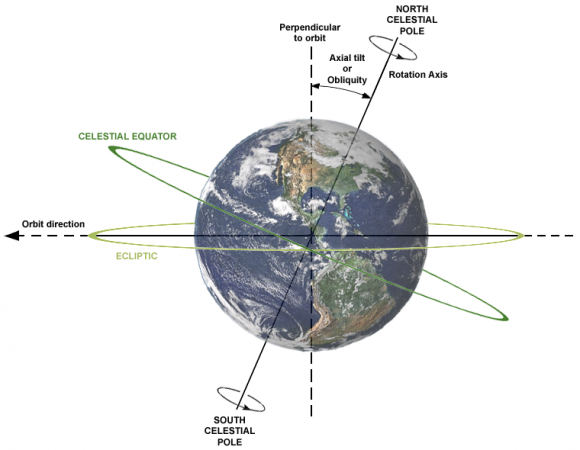
Its growing fever is difficult to explain, Miller says, unless we look at human activities. Research — by Miller and many other scientists — indicates that people are responsible for much of the warming trend. Our impact began around 1750. That marks the approximate start of the Industrial Revolution. Companies began extracting resources in bulk, moving resources and finished goods across the planet and sometimes literally moving mountains to bring people and goods together. To fuel much of this activity, people began intensively burning coal, oil, natural gas and other fossil fuels.
These fuels release pollutant gases as they burn, including carbon dioxide, or CO2. And over the last 250 years, people have burned more fossil fuels, and released more CO2, than at any other time in the history of our species.
Carbon dioxide traps heat in the atmosphere. Over the long term, that extra warmth changes Earth’s climate. The gas also alters the chemistry of the oceans, making their waters more acidic. Together, these changes have affected organisms on land and in the water. Miller believes the changes will leave a mark in the rock record too. And that, he argues, means we have entered the Anthropocene.
From the upper stratosphere to the ocean’s depths
At a laboratory in Boulder, Colo., scientists analyze air samples collected from locations around the world. They use them to learn how the chemistry of Earth’s atmosphere is changing. Every few days, new flasks of air arrive at this lab, which is run by the National Oceanic and Atmospheric Administration, or NOAA.
Colm Sweeney leads the research team that analyzes each air sample for nearly 50 chemicals. As a biogeochemist, he studies interactions between living things and the environment in which they reside. His team focuses on measuring the amount of CO2 in those air samples. Since CO2 traps heat, it’s called a greenhouse gas. (Actual greenhouses use glass to trap heat.) Greenhouse gases are essential for life on our planet. Without them, the average temperature worldwide would be a very frosty -18° Celsius (0° Fahrenheit), instead of the balmy 15 °C (59 °F) that it is today.
Too much of a good thing can be a problem, though. CO2 levels in Earth’s atmosphere have soared. Before the Industrial Revolution, the level was around 280 parts per million. In some places today it exceeds 400 parts per million. That’s huge — an increase of more than 40 percent. Average air temperatures have risen as a result. Since the 1750s, they have climbed by nearly 1 °C (1.8 °F).
But CO2 does more than just linger in the atmosphere, warming the planet. The oceans also soak up large amounts. There, the CO2 leads to changes that can wipe out some sea creatures. And that will leave a telltale sign in the rock record — an absence of formerly common fossils as those species vanish.
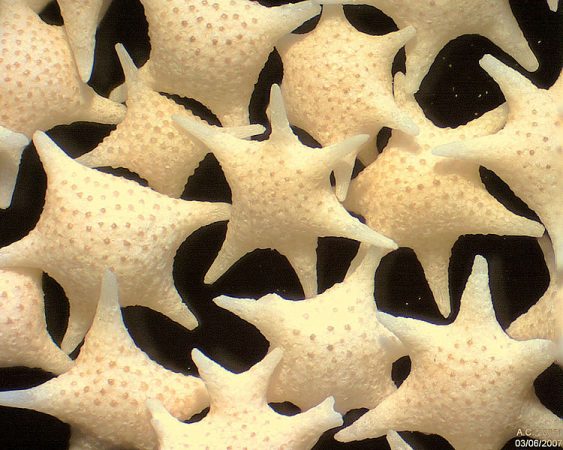
Nearly one-fourth of all the CO2 that enters the air eventually winds up in the ocean. That’s good, since less CO2 in the atmosphere means the air temperatures near Earth’s surface will climb more slowly. But that benefit comes at a cost. When CO2 dissolves into water, it creates carbonic acid. And too much of this acid will spell trouble for sea animals, especially those with shells.
Carbonic acid breaks down a mineral called calcium carbonate. The mineral makes up the shells of many animals, such as corals and clams. It also makes up the shells of tiny one-celled organisms called foraminifera (Fo-RAM-in-IF-er-uh). As protists, these tiny organisms are neither plants nor animals. Most people aren’t even aware they exist. Yet these organisms are hugely important. They live at the base of the marine food web. When ocean water begins to grow more acidic, these and other shelled organisms have a harder time finding the material they need to build their protective shells. That’s why ocean acidification poses a serious and growing threat, not just to foraminifera but to the entire ocean ecosystem.
Learning from history
Fifty-six million years ago, a huge pulse of atmospheric CO2 created just such a problem for ocean life, notes Ellen Thomas. She’s a paleoceanographer at Yale University in New Haven, Conn. She studies the conditions in oceans at times during the distant past. High levels of CO2 in the air — more than double the current level — not only helped to warm the planet way back then. Evidence from deep below the sea floor shows that the high CO2 levels made the ocean water so acidic that it dissolved the shells of many species of foraminifera.
To collect these data, Thomas teamed up with people working on the International Ocean Discovery Program, or IODP. Its paleoceanographers have drilled into the sea floor at many places around the world. At each, they remove tube-like samples of rock, called cores. These cores are hundreds of feet long. Again, just like the pages of a diary, the layers of fossils and sediments that make up each core record the history of the area.
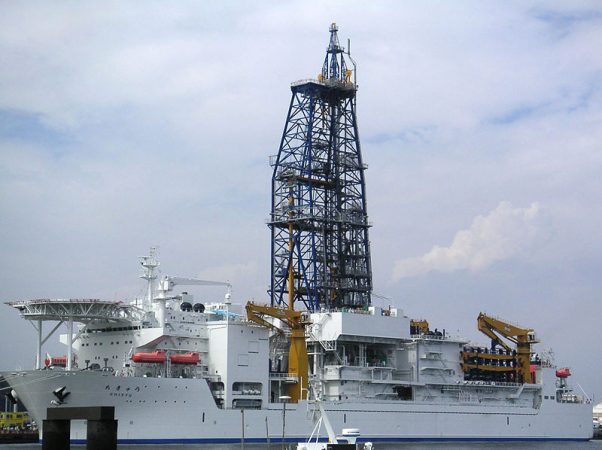
Most layers in the IODP’s cores contain billions and billions of shells from those microscopic foraminifera. Although they had lived in all levels of the ocean, after dying, their remains ended in the same place: piled up, layer upon layer, on the ocean floor.
But a number of the seafloor cores contained a layer that was different. Deposited some 56 million years ago, this layer covered a period of just 5,000 to 10,000 years. It contained almost no fossils, just a layer of barren clay. That clay is made up of sediments that washed into the ocean from distant coastlines. The scientists were surprised to see that clay. Most layers in these cores contain so many foraminifera shells that any minuscule grains of clay are barely visible.
During the few thousands of years when this clay layer was deposited, any shells likely dissolved in the ocean’s acidic waters. So only the clay survived. This wasn’t just a case of the foraminifera not being able to find the building blocks they needed to make their shells. During this period, the acidic water had turned their shells to goo.
A killer acid bath
Such deep ocean waters were simply too acidic for many bottom-dwellers to survive, Thomas explains. As many as half of all bottom-dwelling foraminifera species went extinct during that period. Although 5,000 to 10,000 years sounds like a long time (and it is on a human timescale), it is a brief moment in geologic time. When so many creatures vanish so quickly, scientists refer to it as an “extinction event.”
This extinction event is so clearly visible in the rock record that scientists use it to mark the end of the Paleocene Epoch, 54.8 million years ago, and the beginning of the Eocene Epoch.
Some experts now fear similar evidence is accumulating in the seafloor sediment that will one day turn into a rock record of our time.
The foraminifera living close to the ocean’s surface did not go extinct at the close of the Paleocene, says Thomas. She suspects that’s because CO2 was growing in the atmosphere — and ocean — somewhat slowly. This allowed time for surface waters to circulate. Much of the carbonic acid eventually moved into deeper waters, where it killed off those bottom-dwellers.
But the speed at which people are changing Earth’s atmosphere today will likely mean that even those foraminifera living near the ocean surface will be impacted.
Human activities, especially fossil-fuel burning, are pumping CO2 into the atmosphere (and from there, to the oceans) faster than ever before. Those activities have helped cause CO2 levels in the atmosphere to skyrocket over a span of just a couple of hundred years. Compare that to the thousands of years it took 56 million years ago. When today’s oceans rapidly absorb the gas, carbonic acid doesn’t have time to move to deeper waters, Thomas explains. Instead, it collects near the ocean’s surface, making that water too hostile for the foraminifera there to survive.

The loss of surface formanifera may then ripple throughout the whole marine food web. Extinctions could follow. “Larger areas of the ocean will no longer be hospitable for life other than bacteria,” Thomas worries.
All about the future
Not all scientists agree on whether to officially declare our current geologic period the Anthropocene. One who has concerns about doing so: Stan Finney of California State University, Long Beach. Finney heads the International Commission of Stratigraphy. Stratigraphy is the study of rock layers. And his organization is responsible for setting the geologic time scale.
“There is no doubt humans have affected the Earth,” Finney says. But plants have had a far greater impact, he argues. Plants, and the oxygen they generate, changed the land, the air and the water. “But we don’t name a geological time period for when the plants did what they did,” Finney says. There is no “Plantocene.”
That’s not to say that the term Anthropocene isn’t useful, especially when used casually, he says. In everyday speech, it communicates the impact people are having on our planet. But Finney doesn’t think there’s any reason to create a specific geologic time period to reflect that impact. And that’s partly because there is no way of knowing right now if the human “footprint” on Earth indeed will be visible in the rock record thousands of years from now. It’s possible that Earth’s processes will erase all that we have done.
Only time will tell.
Word Find (click here to enlarge for printing)
